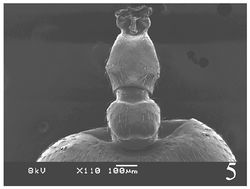Crematogaster physothorax
| Crematogaster physothorax | |
|---|---|

| |
| Scientific classification | |
| Kingdom: | Animalia |
| Phylum: | Arthropoda |
| Class: | Insecta |
| Order: | Hymenoptera |
| Family: | Formicidae |
| Subfamily: | Myrmicinae |
| Tribe: | Crematogastrini |
| Genus: | Crematogaster |
| Species: | C. physothorax |
| Binomial name | |
| Crematogaster physothorax Emery, 1889 | |
Nothing is known about the biology of Crematogaster physothorax.
Identification
Hosoishi and Ogata (2009) - This species is very similar to Crematogaster onusta, but the dorsal portion of the pronotum is characteristic with transverse rugulae.
Keys including this Species
Distribution
This species is known from Malay Peninsula; Myanmar (southeastern parts), Thailand (southern parts) and Malaysia (Peninsula)
Distribution based on Regional Taxon Lists
Indo-Australian Region: Borneo, Indonesia, Malaysia.
Oriental Region: Myanmar (type locality).
Distribution based on AntMaps
Distribution based on AntWeb specimens
Check data from AntWeb
Countries Occupied
| Number of countries occupied by this species based on AntWiki Regional Taxon Lists. In general, fewer countries occupied indicates a narrower range, while more countries indicates a more widespread species. |

|
Estimated Abundance
| Relative abundance based on number of AntMaps records per species (this species within the purple bar). Fewer records (to the left) indicates a less abundant/encountered species while more records (to the right) indicates more abundant/encountered species. |

|
Biology
Castes
Nomenclature
The following information is derived from Barry Bolton's Online Catalogue of the Ants of the World.
- physothorax. Crematogaster deformis r. physothorax Emery, 1889b: 506 (w.) MYANMAR.
- Type-material: lectotype worker (by designation of Hosoishi & Ogata, 2009b: 27), 1 paralectotype worker.
- Type-locality: lectotype Myanmar (“Burma”): Tenasserim, Thagata, iv.1887 (L. Fea); paralectotype with same data.
- Type-depository: MSNG.
- Combination in C. (Physocrema): Emery, 1922e: 140.
- Subspecies of difformis: Emery, in Dalla Torre, 1893: 81 (footnote); Emery, 1895k: 468; Forel, 1903a: 683; Wheeler, W.M. 1919e: 75; Emery, 1922e: 140; Chapman & Capco, 1951: 102; Bolton, 1995b: 160.
- Status as species: Dalla Torre, 1893: 84; Bingham, 1903: 146; Hosoishi & Ogata, 2009a: 6 (redescription); Hosoishi & Ogata, 2009b: 27 (redescription); Pfeiffer, et al. 2011: 46; Khachonpisitsak, et al. 2020: 91.
- Distribution: Malaysia (Peninsula), Myanmar, Thailand.
Unless otherwise noted the text for the remainder of this section is reported from the publication that includes the original description.
Description
Worker
Hosoishi and Ogata (2009) - HW 1.09–1.19; HL 0.97–1.13; CI 104–111; SL 0.89–1.01; SI 84–88; EL 0.20–0.23; PW 0.55–0.63; WL 1.12–1.39; PSL 0; PtL 0.32–0.38; PtW 0.23–0.28; PtH 0.16–0.19; PpL 0.19–0.24; PpW 0.24–0.26; PtHI 50–54; PtWI 71–83; PpWI 106–129; WI 90–106 (Three workers measured).
Workers monomorphic or weakly polymorphic in size.
Scape reaching posterior corner of head.
In lateral view, pronotum and mesonotum forming a single convexity; propodeum slightly raised relative to promesonotum. Anterior margin of pronotal collar slightly concave in dorsal view. Metanotal groove almost straight in dorsal view, not so deep and situated posteriorly to the posterior ridge of pronotum in lateral view; thorax not strongly constricted in middle in dorsal view. In dorsal view, a few longitudinal rugulae connecting between mesonotum and propodeum; but the boundary distinct. Propodeal spiracle situated near the metapleural gland orifice, the distance between them about the same as the propodeal spiracle diameter. Propodeal spines absent.
Clypeus sculptured with longitudinal rugulae. Integument essentially smooth and shining. Rugulae present on the anterior portion of dorsal face of head. Transverse rugulae present on the posterior portion of pronotum.
Standing pilosity sparse, a few pairs on dorsal face of head and promesonotum. Dorsal face of head with appressed setae. Clypeus with decumbent setae. Fourth abdominal tergite with appressed setae.
Body color black.
Type Material
Hosoishi and Ogata (2009) - LECTOTYPE worker (by present designation) and one paralectotype worker from MYANMAR: Thagata, Tenasserim, iv. 1887 (Fea) (Museo Civico di Storia Naturale, Genoa) [examined].
References
- Hosoishi, S. & Ogata, K. 2009b. A taxonomic revision of the Asian endemic subgenus Physocrema of the genus Crematogaster. Zootaxa 2062: 15-36.
- Khachonpisitsak, S., Yamane, S., Sriwichai, P., Jaitrong, W. 2020. An updated checklist of the ants of Thailand (Hymenoptera, Formicidae). ZooKeys 998, 1–182 (doi:10.3897/zookeys.998.54902).
References based on Global Ant Biodiversity Informatics
- Emery C. 1889. Formiche di Birmania e del Tenasserim raccolte da Leonardo Fea (1885-87). Annali del Museo Civico di Storia Naturale 27: 485-520.
- Forel A. 1903. Les Formicides de l'Empire des Indes et de Ceylan. Part X. J. Bombay Nat. Hist. Soc. 14: 679-715.
- Helms J. A., S. M. Helms, N. I. Fawzi, Tarjudin, F. Xaverius. 2017. Ant community of an Acacia mangium forest in Indonesian Borneo. Serangga 22(1): 147-159.
- Hosoishi S. and K. Ogata. 2009. A check list of the ant genus Crematogaster in Asia (Hymenoptera: Formicidae). Bull. Inst. Trop. Agr. Kyushu Univ. 32: 43-83.
- Hosoishi S., and K. Ogata. 2009. A taxonomic revision of the Asian endemic subgenus Physocrema of the genus Crematogaster (Hymenoptera: Formicidae). Zootaxa 2062: 15-36.
- Hosoishi S.; and K. Ogata. 2009. The ant genus Crematogaster Lund, subgenus Physocrema Forel, in the Indochinese Peninsula. Asian Myrmecology 2 (2008): 1-10.
- Hosoishi, S. and K. Ogata. 2008. The ant genus Crematogaster Lund, subgenus Physocrema Forel, in the Indochinese Peninsula (Hymenoptera: Formicidae). Asian Myrmecology 2:1-10.
- Pfeiffer M.; Mezger, D.; Hosoishi, S.; Bakhtiar, E. Y.; Kohout, R. J. 2011. The Formicidae of Borneo (Insecta: Hymenoptera): a preliminary species list. Asian Myrmecology 4:9-58
- Wheeler W. M. 1919. The ants of Borneo. Bulletin of the Museum of Comparative Zoology 63:43-147.


